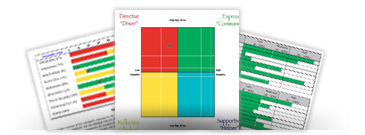B2B Inside vs Outside Roles
B2B Sales Training for Balancing Inside vs. Outside Roles
One of the first things that putting sales staff through career aptitude assessments reveals is that they fall into two general camps: those who do well in outside sales, otherwise known as “hunters;” and those who excel at inside sales, sometimes referred to as “farmers” if they also have a follow-on customer support role.
B2B sales training should take these roles into account, as each requires specialized training. Furthermore, failing to identify those with the natural aptitude for a given role can lead to poor performance and a high turnover rate, so knowing the traits of each is important.
The Role of the Outside Salesperson
Outside sales personnel are generally the top earners in any sales organization, as they have the ability to create “something out of nothing.” In other words, you could have a firm that has just launched, with zero customers in the database, and a top outside sales force can bring in business without so much as a dime spent in marketing. Good outside salespeople are the rainmakers — the ones that hunt prospects and turn them into customers on their own initiative.
When supported by good marketing, B2B sales training, and assistants to take care of paperwork and deal minutia, they thrive.
The Role of the Inside Salesperson
The inside salesperson is a problem-solver and relationship builder. He or she generates business by servicing past and current clients, and in doing so uncovers opportunities for upselling and cross-selling. An inside salesperson is also expert at handling inbound inquiries from marketing efforts and converting them into sales-ready qualified leads.
An inside salesperson generally performs more account management functions than an outside salesperson. Good ones are often considered by customers to be part of their team, rather than just a vendor.
Achieving Balance and Training Needs
No sales organization can thrive without a balance between the two primary sales roles. Too many inside sales “farmers” will lead to contraction as there is no new hot prospects being brought in. Likewise, an imbalance towards aggressive outside sales people will not build loyalty among clients, as information flow and account management functions will suffer.
The trick is to achieve a balance, and this will require a different ratio of inside and outside salespeople for each specific business in accordance with how it procures most of its leads. Businesses just starting out would require a larger outside sales force to gain market share, while established businesses with large customer rosters should lean towards inside sales to farm those customers for more revenue.
Each role should also undergo specialized B2B sales training. While things such as handling objections, dealing with the different buyer types, and closing techniques apply to both roles, prospecting and account management functions for each are quite different.
Cross them up, as in the case where an inside salesperson is out chasing leads all day while an outside salesperson does mostly paperwork, and the results will be poor. This absurd situation occurs in sales organizations across the world, every single day. Usually it occurs because the salesperson’s aptitude has not been assessed, and he or she has been placed in an unsuitable role based on opinion rather than measurable facts.
Test your people with a proven tool, such as the APQ Aptitude Assessment. Put them in the appropriate sales role based on the results. And then give them the right training for their role. This is the key to building a balanced, strong sales team.
The Sales Team Roadmap is The Start To Your Sales Success
Three Powerful Sales Guides, Instant Results

A terrific sales seminar. I have been in the field for over 30 years and have never attended a better seminar. Up to date and relevant for today’s new selling paradigm.











